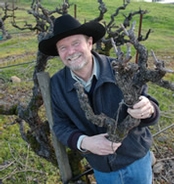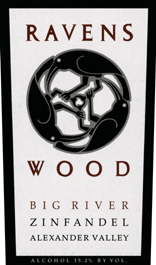For wine lovers, Ravenswood has become something of a Yogi Berra line: "Nobody drinks that anymore. It’s too popular."
The winery Joel Peterson started with partner Reed Foster in 1976 with $4,000, no vineyards and no building has grown into a million-case brand after being sold to Constellation Brands in 2001 for $148 million. It makes its money from its bottom-end Vintners Blend lineup, which are competent wines but not really distinguishable from other $10 items in Constellation’s portfolio.
$4,000, no vineyards and no building has grown into a million-case brand after being sold to Constellation Brands in 2001 for $148 million. It makes its money from its bottom-end Vintners Blend lineup, which are competent wines but not really distinguishable from other $10 items in Constellation’s portfolio.
But there are still gems at Ravenswood: Peterson’s lineup of single-vineyard Zinfandels. To me, these are some of the best expressions of terroir in Zinfandel — hard as that is to believe from a label you’re used to seeing at liquor stores where the clerk hides behind bulletproof glass.
There are only six of these Zins, five from Sonoma County and one from Napa, and they represent less than 1% of Ravenswood’s production. They’re not tiny production wines, ranging from 980 to 3,560 cases, but Ravenswood’s distribution is so widespread that you rarely see more than one on any wine list.
That’s a shame, because it’s great fun to taste them together. Three of the vineyards — Barricia, Old Hill and Teldeschi — are within a few miles of each other in Sonoma Valley, but the wines are tremendously different. Unlike some wineries that bend all their single-vineyard wines to a certain style, there seems to be no Ravenswood signature taste for this lineup, and that’s a good thing.
Moreover, at a time when Zins are getting enormous bodies, the Ravenswood single-vineyard wines stay within a relatively restrained range of 14.5 to 15 percent alcohol.
"The three sins of Zin are too much sugar, too much alcohol and too much oak," Peterson says. "The oak will destroy it. The sugar will soften it up and make it jammy. But it’s where Zinfandels have lost their soul and become bad food wines."
It’s strange to imagine the guy behind the "no wimpy wines" slogan worrying about food pairing — unless you know the man. Peterson, 62, may be a corporate vice-president who likes wearing a cowboy hat to events. But he’s also a non-dairy vegetarian who won over his second wife by reading poetry to her when their car ran out of gas on the New Jersey Turnpike — and managed to keep her even after he followed Constellation’s orders and fired her. He’s a microbiologist who once rode across the country on a motorcycle without any money. And if he ever lost all the loot (and the electric Tesla car) he earned from the brand sale, he could probably support himself as an itinerant storyteller.
"My parents were both chemists, and they were gin drinkers," Peterson says. "My mother was bored one day and she read a book that said, ‘Food should go with wine.’ This was 1951. So she went looking for a bottle of wine to go with Thanksgiving dinner. She got a 1945 Chateauneuf du Pape that the wine shop recommended. If it had been ’42, ’43 or ’46 I probably wouldn’t be here today."
It turns out the Peterson genes are fully loaded with a good palate. His parents became leaders of the San Francisco Wine Tasting Club (which had members like future Ridge Vineyards president Paul Draper), and his mother moonlighted as a recipe tester for Chez Panisse chef Alice Waters. His son Morgan, now 28, made his first wine at age 5 and now has his own small company, Bedrock Wine Co. And his son Galen, 11, made his first barrel of wine this year.
That’s a late start in his family, though: Joel Peterson’s family asked him to take tasting notes at their club starting at age 10.
Now his tastings are different. In 2006, Peterson told me some of the samples he had to go through for Vintners Blend wines were so bad that they gave him nosebleeds. At the time he was pulling back from Vintners Blend, but today he says, "I’m involved in every final blend. No wine goes out of the winery without my approval. Even the Vintners Blend."
It’s obvious, though, that his first love is still the single-vineyard Zins, and it’s easy to taste why.
My favorite changes from vintage to vintage. From the ’07s, I was a big  fan of the Big River ($35), an Alexander Valley vineyard planted in the 1890s. The wine has a nice spiciness with good cherry fruit and cinnamon notes that linger through the finish.
fan of the Big River ($35), an Alexander Valley vineyard planted in the 1890s. The wine has a nice spiciness with good cherry fruit and cinnamon notes that linger through the finish.
I always like the Old Hill Ranch, though at $60, I expect to. Planted about 1880 in a warm part of Sonoma Valley, this is the oldest vineyard in Ravenswood’s portfolio and is usually the most complex of its single-vineyard Zins — no wonder, because while the vineyard is 76% Zin, it has 14 other varieties planted, some of which haven’t been clearly identified. The 2007 Old Hill is typically intense and interesting, with black and red berries, floral and earth notes, and a long finish. It’s quite tannic, but that’s because Peterson makes this wine to age; the 1997 is mature but still fresh and lovely.
With the delicious Old Hill still on my lips, I prodded Peterson by asking if working for Constellation had made his winemaking more safe. He bristled.
"Constellation hasn’t ever messed around with the winemaking," he said. "We’re working for a huge company, but we’re working for little units of a big company. We go to an annual meeting and winemakers do presentations on things they’ve learned — the effect of oxygen on the transportation of wine in tankers, that sort of thing. It’s like you’re going to a convention on cellular techniques in biology. When you see a corporation, you think uniformity, you think conformity. So far, it’s not true."
Since he’s a vice-president, that’s actually kind of a shame. I’d love to see a whole corporation full of Hawaiian shirt-wearing scientists willing to arm wrestle a merchant marine in Portugal for meal money. Peterson hasn’t gotten boring yet, and neither have his single-vineyard wines.
